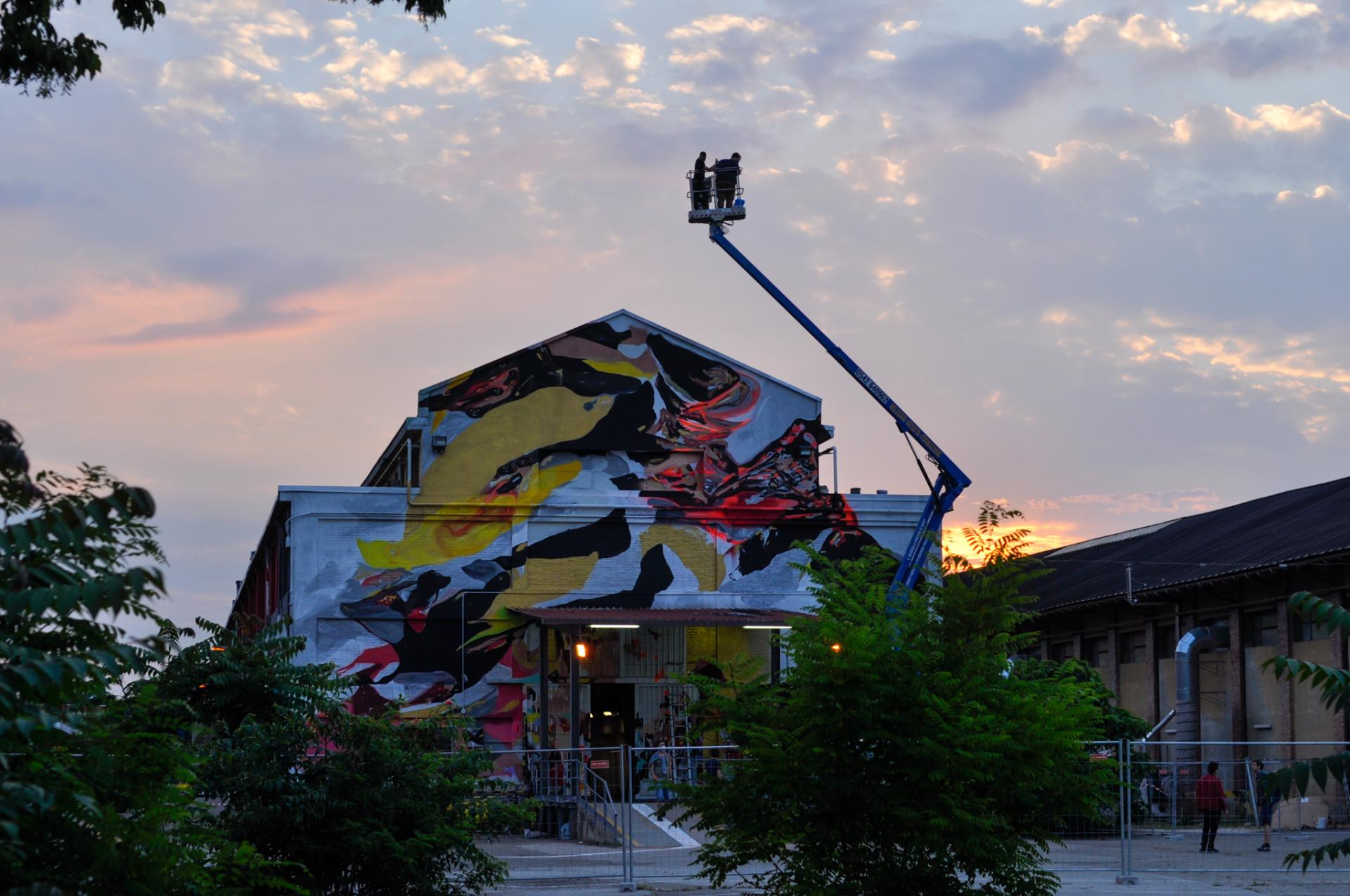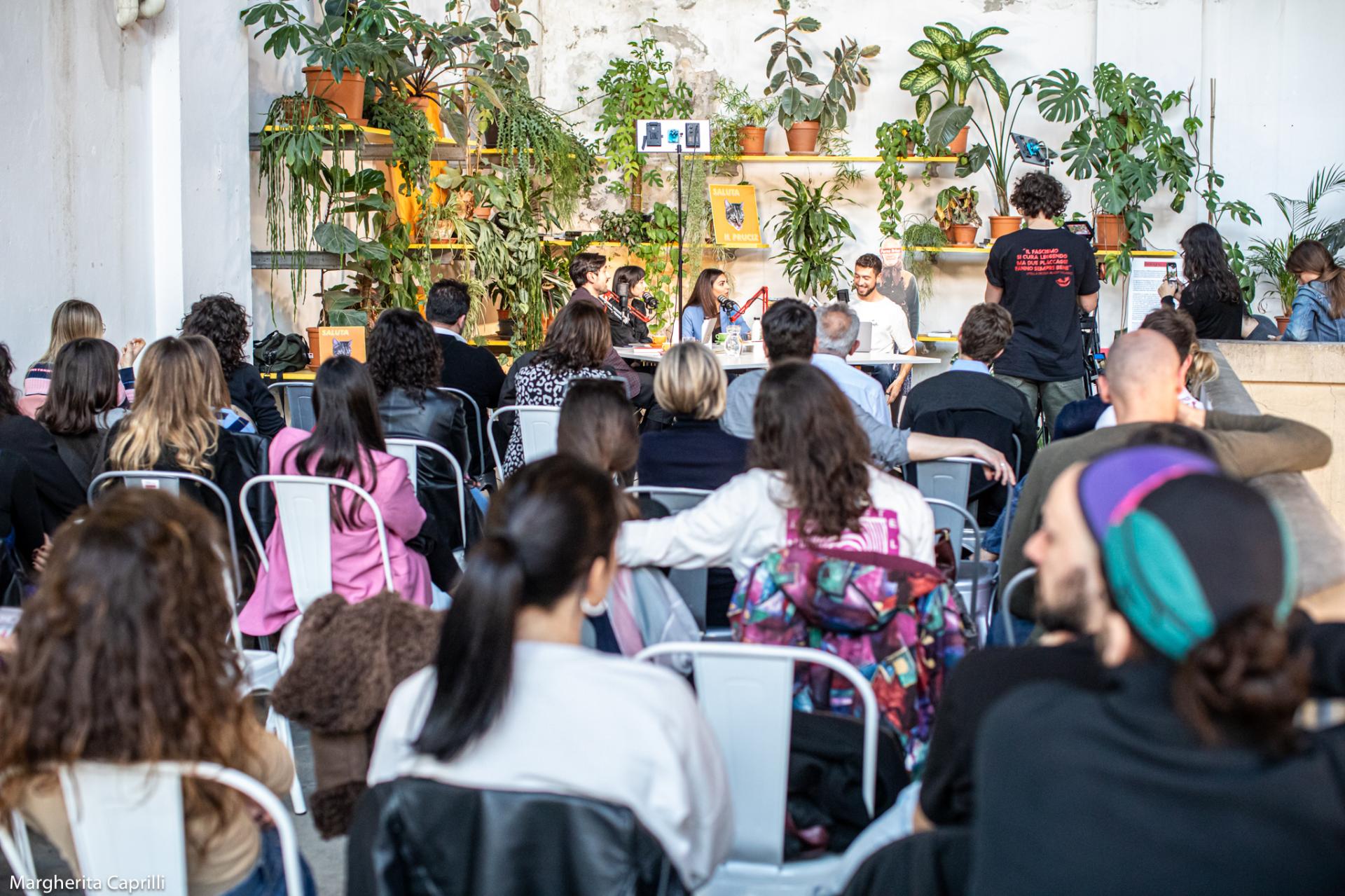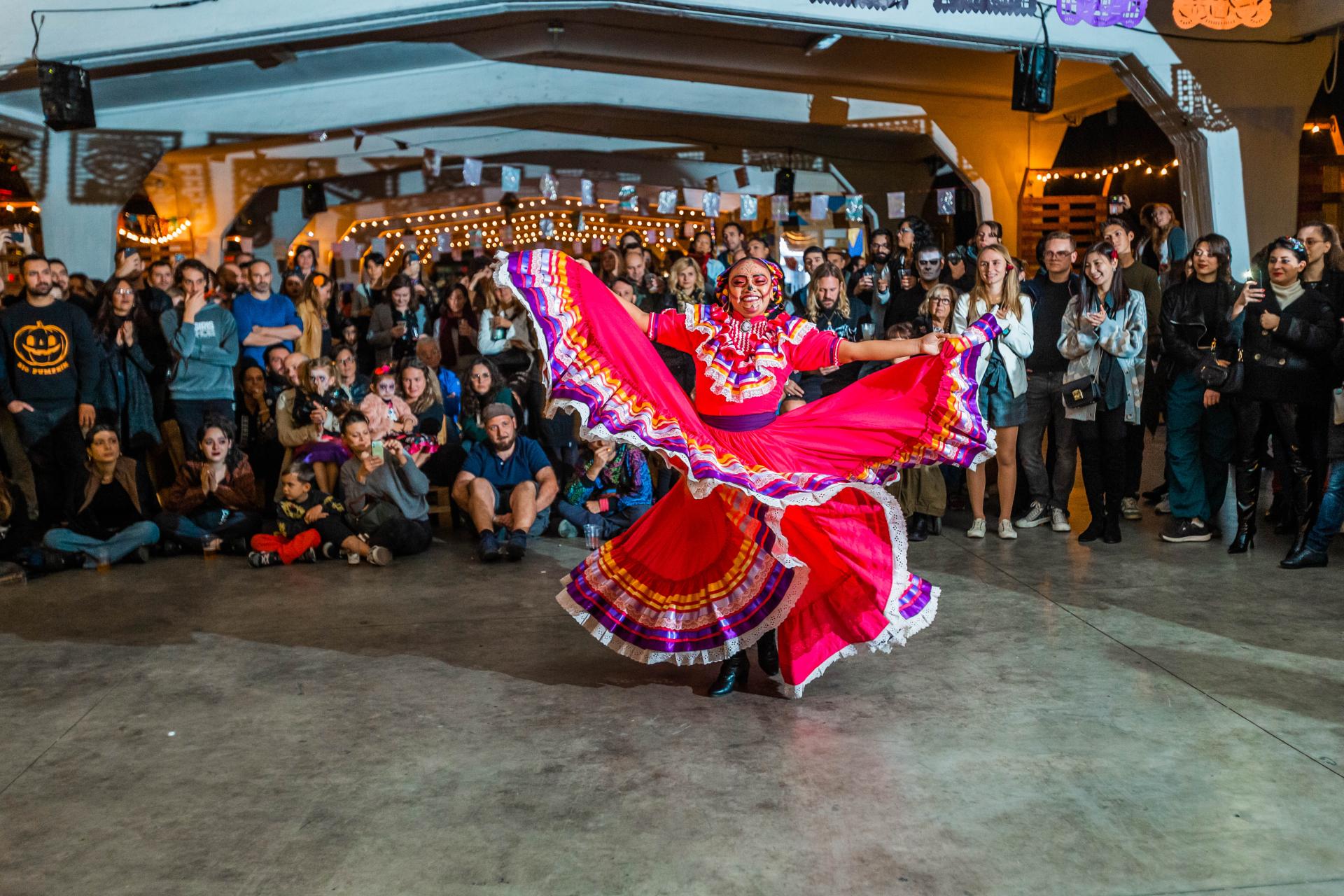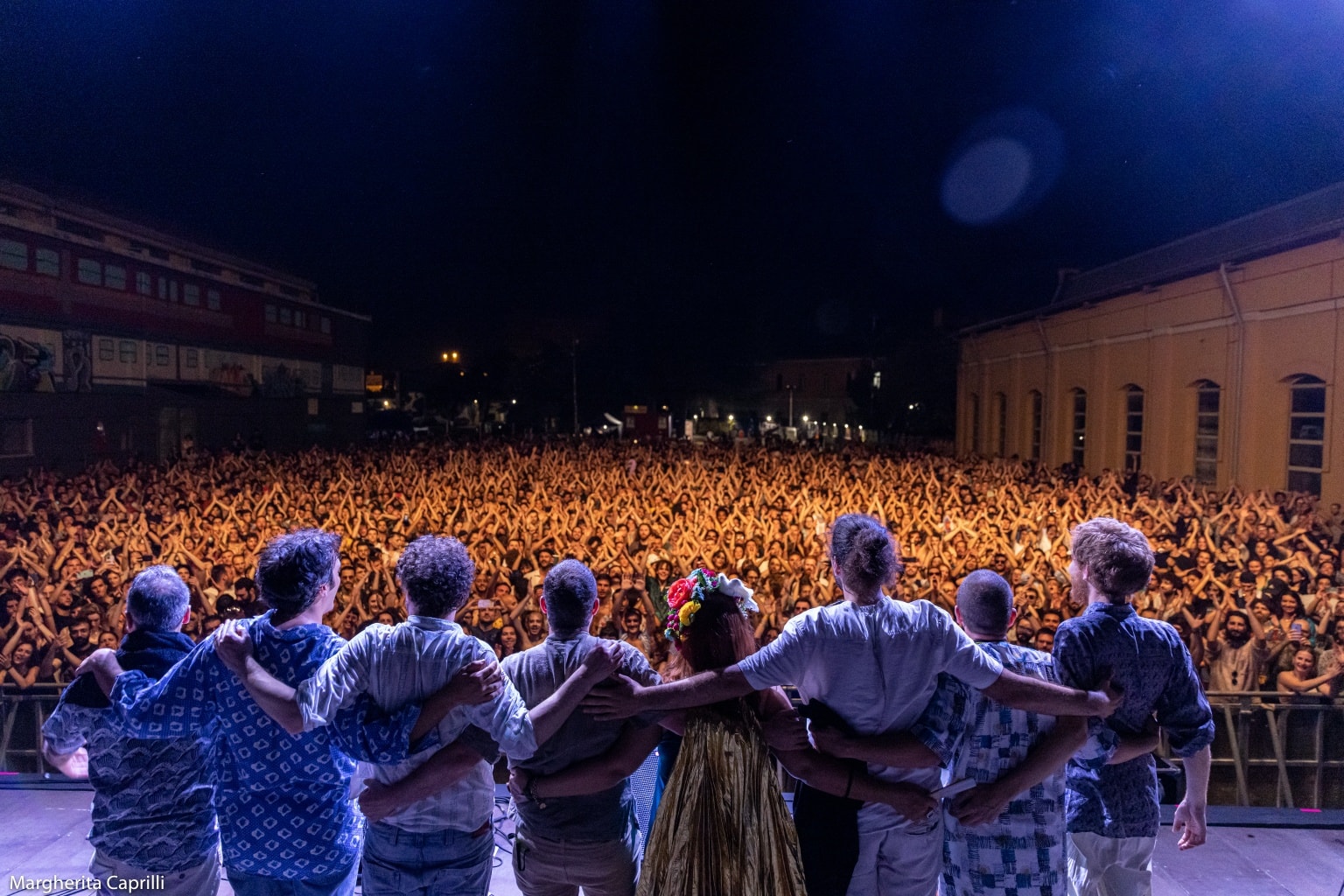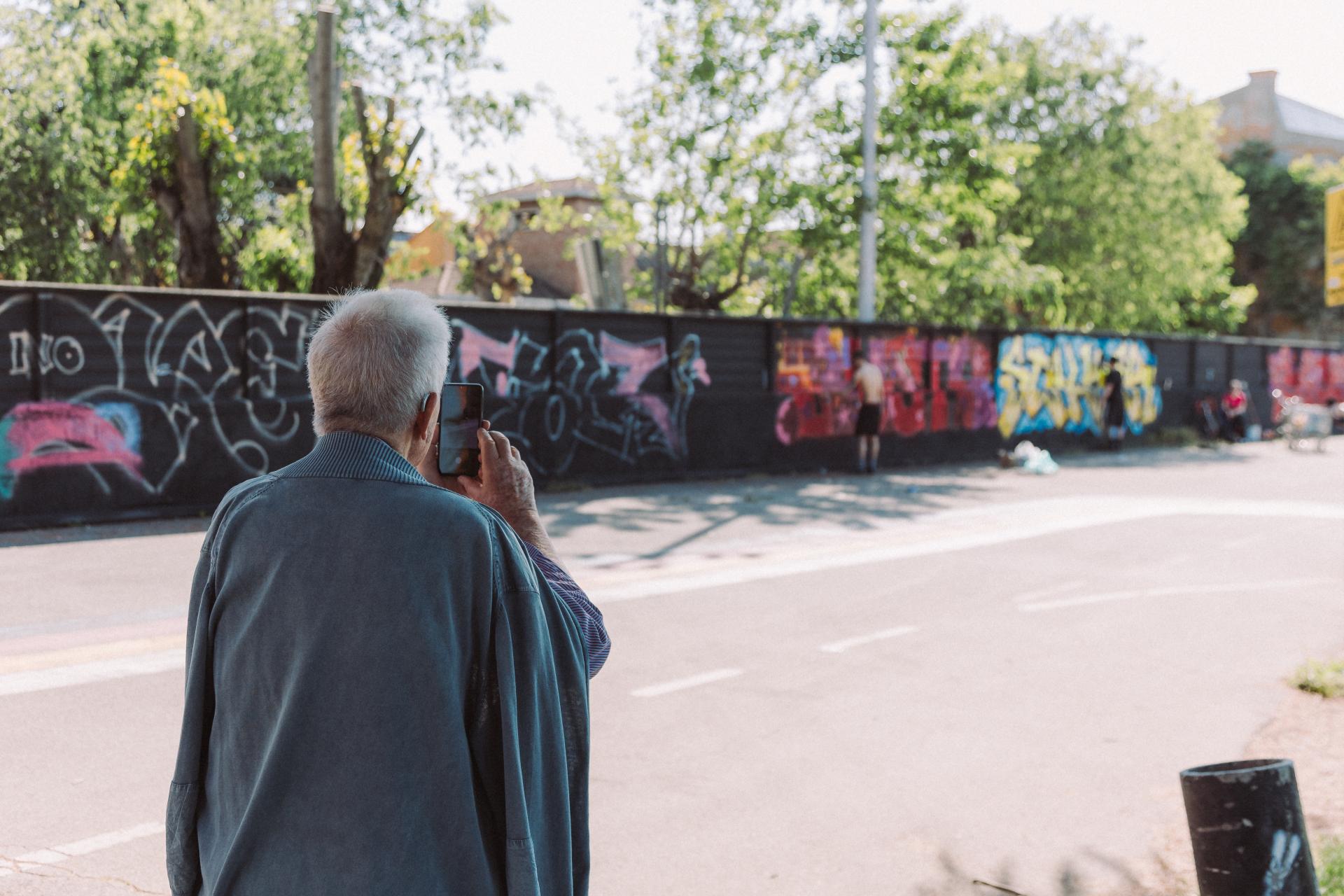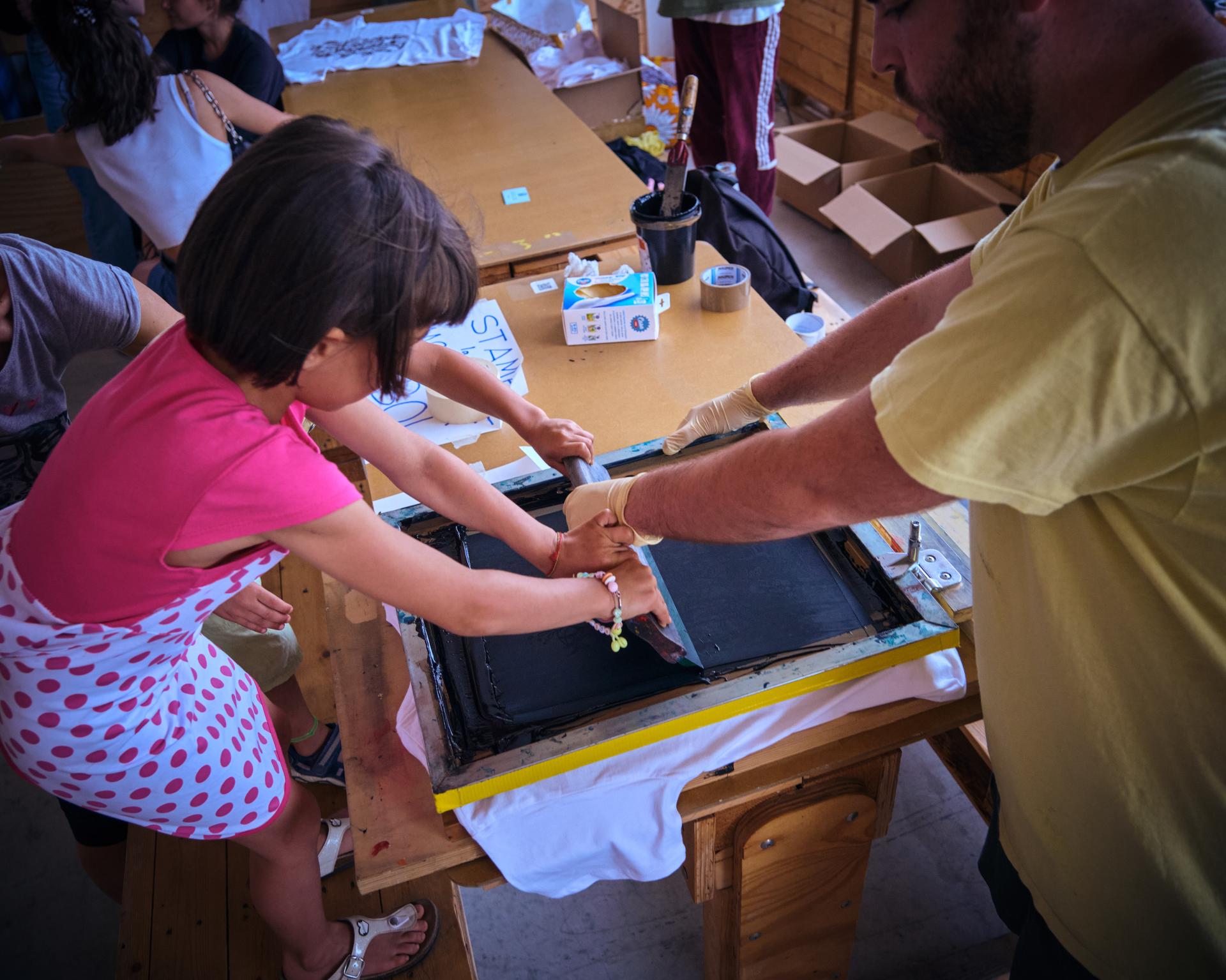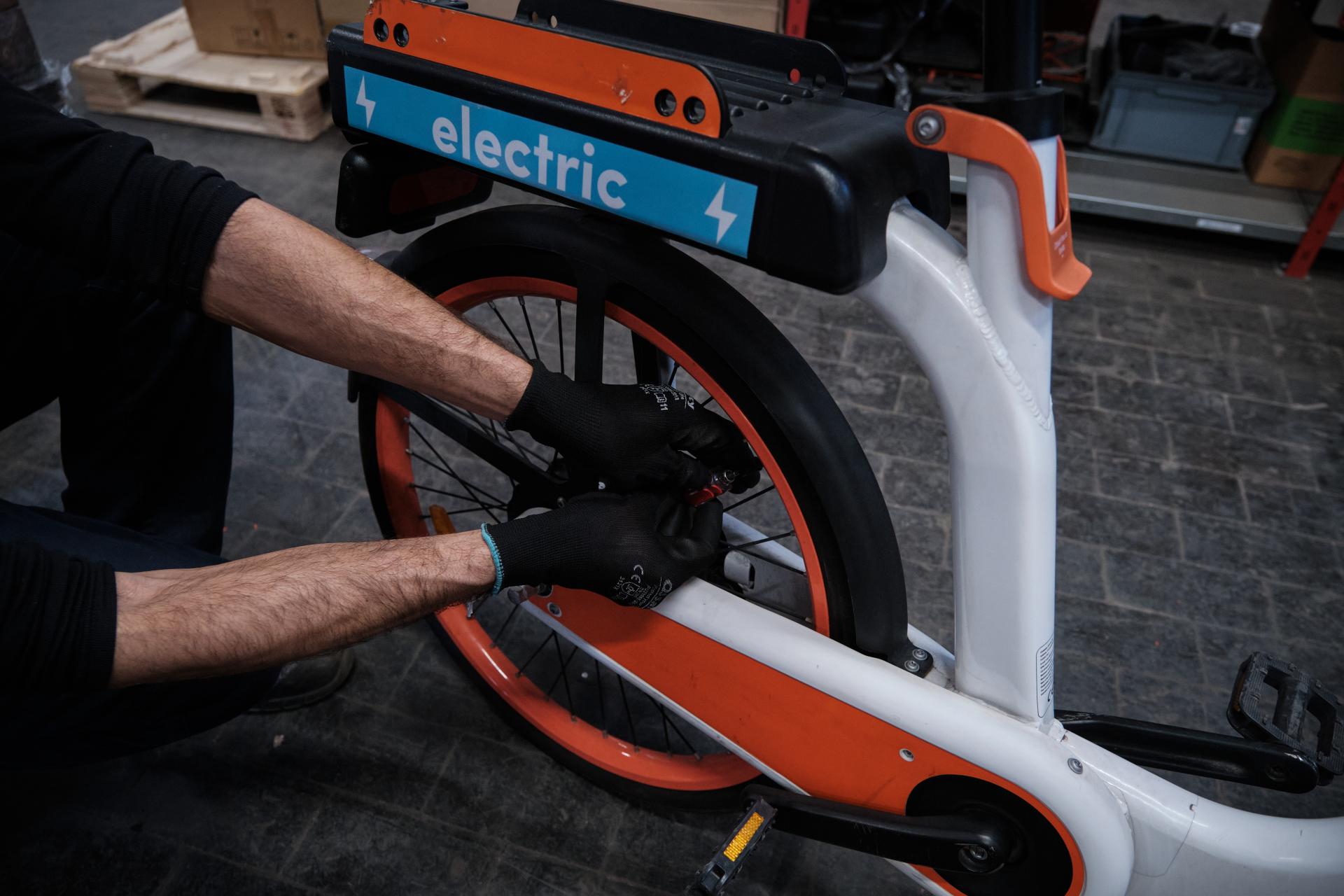DumBO
Basic information
Project Title
DumBO
Full project title
Distretto Urbano Multifunzionale di Bologna
Category
Prioritising the places and people that need it the most
Project Description
A former abandoned railway yard transformed into a vibrant creative hub for music, innovation and sustainability: that's DumBO!
Geographical Scope
Regional
Project Region
Emilia-Romagna, Italy
Urban or rural issues
Mainly urban
Physical or other transformations
It refers to other types of transformations (soft investment)
EU Programme or fund
No
Description of the project
Summary
DumBO is a financially self-sustaining temporary redevelopment of an abandoned railway yard in Bologna, dedicated to art and culture, sustainability, circular economy, inclusion, social innovation, sport. Thanks to its large dimension (6 buildings, a total area of over 18,000 sqm plus 20,000 sqm uncovered) and versatility, DumBO is able to propose a diversified and qualified cultural and social offer: music, art and photography, civic laboratories, exhibitions, urban sport events, workshops, film festivals. A transversal and cross-sectoral programming, which takes into account audience accessibility in all its forms.
DumBO's governance consists of a public-private partnership that includes the company Open Event, the Municipality of Bologna, Fondazione per l’Innovazione Urbana (that is, a multidisciplinary urban regeneration research, development, co-production and communication centre), Legacoop Bologna, the architecture and urban planning studio Performa Architettura+Urbanistica.
Nowadays more than 20 individuals/organizations joined the DumBO community and are now part of the "DumBO district" - that is, a real community made up of artists and artistic collectives, communication agencies, cultural and sports associations, cooperatives and companies operating in the cultural and creative sectors, architecture studios and sustainable engineering firms - who found in DumBO an open and stimulating context, consistent with their mission and values.
The project was initiated by a participatory process managed by Fondazione per l’innovazione Urbana that involved the neighbourhood and set the agenda for the regeneration of the area.
Nowadays DumBO provides affordable space for students and CCIs, and encourages interactions between social organisations, entrepreneurs and the neighbours.
The project includes a food court with a social bistro, a social grocery store, event spaces, urban sport halls, co-working areas, a urban agriculture garden
DumBO's governance consists of a public-private partnership that includes the company Open Event, the Municipality of Bologna, Fondazione per l’Innovazione Urbana (that is, a multidisciplinary urban regeneration research, development, co-production and communication centre), Legacoop Bologna, the architecture and urban planning studio Performa Architettura+Urbanistica.
Nowadays more than 20 individuals/organizations joined the DumBO community and are now part of the "DumBO district" - that is, a real community made up of artists and artistic collectives, communication agencies, cultural and sports associations, cooperatives and companies operating in the cultural and creative sectors, architecture studios and sustainable engineering firms - who found in DumBO an open and stimulating context, consistent with their mission and values.
The project was initiated by a participatory process managed by Fondazione per l’innovazione Urbana that involved the neighbourhood and set the agenda for the regeneration of the area.
Nowadays DumBO provides affordable space for students and CCIs, and encourages interactions between social organisations, entrepreneurs and the neighbours.
The project includes a food court with a social bistro, a social grocery store, event spaces, urban sport halls, co-working areas, a urban agriculture garden
Key objectives for sustainability
Sustainability is the pillar of the project. In fact, DumBO is based on the principle of "zero land consumption", as it arises from the regeneration of an abandoned area settled in a peripheral context using mainly re-used materials (bricks, containers...), taking in consideration recyclability, but also the principles of re-use and circularity. Many members of DumBO district are committed to sustainability/circularity and their participation to the regeneration process has allowed the achievement of important objectives in terms of reducing its environmental impact (the company Ar.Co Wood designed and built the set up of the spaces by using mostly recycled wood pallets), and of raising public awareness of issues such as recycling, reuse, sustainable mobility: the circular economy hub BackBO focuses on how to overcome the throwaway culture, through best practices (specific training, non-disposable glasses providing) and workshops; the leading player in the industry of EU shared micromobility RideMovi has moved its Bologna's hub inside DumBO and together we have created biking paths and bicycle parking areas, reducing the traffic congestion and emission in the neighborhood; Free Walking Tour Bologna designs tours in the neighborhood by exploring the periphery potential in creating a more sustainable and diffused urban tourism; the association Equi-Libristi recovers and free-puts-back in the circulation of books before they are recycled.
In 2023, DumBO developed and implemented a green strategy based on the circular economy paradigm that includes environmentally friendly practices, a smarter model of waste management and the involvement of local communities. these activities are included under the "DumBO Green District" label.
In 2023, DumBO developed and implemented a green strategy based on the circular economy paradigm that includes environmentally friendly practices, a smarter model of waste management and the involvement of local communities. these activities are included under the "DumBO Green District" label.
Key objectives for aesthetics and quality
One of the objectives of DumBO project was to provide a welcoming, collective space for people and creatives, to identify and point out opportunities, to make a building habitable again, to integrate it back into the city and to use it generously. Since the beginning, DumBO aspired to be a meaningful part of people's everyday life, a place where everybody feels like home, and where everyone, from kids to adults, can really be her/himself and express her/his own creativity and personality.
To achieve these objectives, together with the members of DumBO district and the support of volunteers, kids, neighbors and local community, we designed and realized furniture elements and structures of the area and of the urban garden, by using mainly recycled materials. The outputs are very peculiar co-designed spaces with fresh looks, 100% wheelchair accessible and reduced environmental impacts.
As a result of artistic workshops and activities, nowadays the general aesthetics of the area strongly relies on urban art and graffiti (of which Bologna has been an important cradle over the nineties), creating a historical and thematic continuum and implementing a mutual valorisation between content and container.
Thanks to all that, nowadays DumBO provides a warm, welcoming and beautiful urban environment, despite the low budget available for its development.
To achieve these objectives, together with the members of DumBO district and the support of volunteers, kids, neighbors and local community, we designed and realized furniture elements and structures of the area and of the urban garden, by using mainly recycled materials. The outputs are very peculiar co-designed spaces with fresh looks, 100% wheelchair accessible and reduced environmental impacts.
As a result of artistic workshops and activities, nowadays the general aesthetics of the area strongly relies on urban art and graffiti (of which Bologna has been an important cradle over the nineties), creating a historical and thematic continuum and implementing a mutual valorisation between content and container.
Thanks to all that, nowadays DumBO provides a warm, welcoming and beautiful urban environment, despite the low budget available for its development.
Key objectives for inclusion
DumBO is inclusive by design: it presents no physical barriers and it can be accessed by everybody without distinction of any sort. It’s barrier-free, designed to be freely and openly accessible to diverse groups of people, with special attention given to the inclusion of children and young people. The project also strives to create a living community where various groups can come together, meet and interact, thanks to a diversified and qualified cultural and social offer, whose events are most of the times free to attend or where the entrance tickets are cheap, to give everyone the opportunity to attend. DumBO outdoor areas are equipped with urban sport facilities (skatepark, basket ground, bowls pitches), freely accessible. The activities managed by our district members working in sport fields are especially addressed to youth centres, schools, communities for immigrants and young people from disadvantaged/deviance situations. The project arises from the lack of open spaces and sites of informal gathering for individuals and groups especially in the neighborhood; therefore, the project's goal is based on public participation since its beginning, initiated by receptive citizens and managed by local institutions.
DumBO stimulates public inclusion and participation, also organizing and hosting various socio-educational activities in order to inspire creative debates, support innovative ideas and address pressing social issues. It regularly offers training courses for the reintegration into employment of women and groups at risk, in collaboration with local experts. In the end, the objective of the project is not only to guarantee informal accessibility to the spaces, but also to give a thoughtful structure to the process of building social cohesion within the community.
DumBO is very student-friendly, providing more than 10 free workstations and a co-working space, with fully equipped desks. DumBO employs adults with difficulties, through special work grants.
DumBO stimulates public inclusion and participation, also organizing and hosting various socio-educational activities in order to inspire creative debates, support innovative ideas and address pressing social issues. It regularly offers training courses for the reintegration into employment of women and groups at risk, in collaboration with local experts. In the end, the objective of the project is not only to guarantee informal accessibility to the spaces, but also to give a thoughtful structure to the process of building social cohesion within the community.
DumBO is very student-friendly, providing more than 10 free workstations and a co-working space, with fully equipped desks. DumBO employs adults with difficulties, through special work grants.
Results in relation to category
Through the project, an abandoned manufacturing building was transformed into a charming, vibrant and inclusive public space that actively contributed to the social and economic revitalization of the surrounding neighborhood, from several points of view.
First of all, it reinforced the identity of the surrounding neighborhood by becoming its main landmark: a big-sized cultural space that combines the charm of a post-industrial city with local features of contemporary cultural dynamics and lifestyles. That attracted artists, creatives and organizations to establish their headquarter at DumBO, creating an open community that generates new connections between culture, art and society, in a virtuous circle that strengthens day by day.
Because of its participatory methodology, the project successfully engaged civil society and grass-roots associations in the process of design and implementation: that enhanced citizens’ self esteem and the sense of community and solidarity between community members. The engagement of local residents in the participative process strengthened their sense of belonging to the space and, more in general, to the neighborhood.
Thanks to its evocative spaces and its cultural programming, DumBO also became a tourist destination for the city of Bologna, transforming a neglected area into a lively location able to create new jobs and employment opportunities.
In terms of environmental sustainability, the implementation of a "customized" green strategy aimed to increase the environmental sustainability of the music events/festivals organized at DumBO.
First of all, it reinforced the identity of the surrounding neighborhood by becoming its main landmark: a big-sized cultural space that combines the charm of a post-industrial city with local features of contemporary cultural dynamics and lifestyles. That attracted artists, creatives and organizations to establish their headquarter at DumBO, creating an open community that generates new connections between culture, art and society, in a virtuous circle that strengthens day by day.
Because of its participatory methodology, the project successfully engaged civil society and grass-roots associations in the process of design and implementation: that enhanced citizens’ self esteem and the sense of community and solidarity between community members. The engagement of local residents in the participative process strengthened their sense of belonging to the space and, more in general, to the neighborhood.
Thanks to its evocative spaces and its cultural programming, DumBO also became a tourist destination for the city of Bologna, transforming a neglected area into a lively location able to create new jobs and employment opportunities.
In terms of environmental sustainability, the implementation of a "customized" green strategy aimed to increase the environmental sustainability of the music events/festivals organized at DumBO.
How Citizens benefit
The project aims to provide affordable spaces and services for a wide range of urban people (people from the local community, entrepreneurs, volunteers, etc.) with different levels of income (‘hipsters’, families in need,etc.), and to create a new way of living together. Some of the activities that take place at DumBO offer advantageous conditions for underprivileged users, and put in place systems such as double pricing. Job programmes from the social organisations that are part of DumBO district have helped local youngsters with difficulties on the regular job market to find jobs. In this sense, the project allows people in situations of precariousness and social exclusion to find welcoming spaces in the city centre.
The project in its whole literally fostered social and urban regeneration in the neighborhood, transforming it into a more welcoming area for anyone passing by, giving it an overall sense of care and beauty and making it more navigable for tourists and residents.
The project started through civic-society neighborhood involvement managed by Fondazione per l’innovazione Urbana, working towards rethinking the Ravone district (where DumBO is settled) within the urban landscape of Bologna. After that, what made the project possible was a line of successful partnerships that generated a community of individuals and collectives wanting to come together to support the creation of the DumBO district.
After that, a mixed governance gathered around the same objectives, putting together the different tenants and other stakeholders (social and cultural partners, entrepreneurs, neighborhood). This created a strong network that has been extended and strengthened over the past years with investors, suppliers, and new partnerships, including a partnership with the local authority.
The project in its whole literally fostered social and urban regeneration in the neighborhood, transforming it into a more welcoming area for anyone passing by, giving it an overall sense of care and beauty and making it more navigable for tourists and residents.
The project started through civic-society neighborhood involvement managed by Fondazione per l’innovazione Urbana, working towards rethinking the Ravone district (where DumBO is settled) within the urban landscape of Bologna. After that, what made the project possible was a line of successful partnerships that generated a community of individuals and collectives wanting to come together to support the creation of the DumBO district.
After that, a mixed governance gathered around the same objectives, putting together the different tenants and other stakeholders (social and cultural partners, entrepreneurs, neighborhood). This created a strong network that has been extended and strengthened over the past years with investors, suppliers, and new partnerships, including a partnership with the local authority.
Physical or other transformations
It refers to other types of transformations (soft investment)
Innovative character
The innovative character of the project is based mainly on four pillars:
- size and position: DumBO represents a flagship project of urban regeneration in Italy, due to its size and position: it successfully transformed a former 40,000 sqm-abandoned manufacturing building that housed a railway yard into an inclusive community building, by using simple materials and working imaginatively with large-scale gestures.
- public engagement: in general terms, one of the keys to successfully facilitating urban regeneration projects is to encourage local community participation, because participation produces more than just outcomes. The project experimented the human, urban and social regeneration strategy named Bologna si Attiva, based on an unprecedented collaboration for the city of Bologna, which sees the public and private sector and civil society actively working together to plan activities and to co-define function and design of some of the spaces. So, DumBO represents a centre with a strong community voice.
- urban regeneration model: the DumBO project conveys a cooperative and participatory model of urban regeneration, based on the ability to involve the vibrancy of stakeholders and urban design energies, an innovative governance capable of regeneration operations combined with creative techniques of participation and involvement and work out entirely new operations, economically viable, socially rewarded.
- cross-sectorial: DumBO offers a great opportunity to showcase innovative solutions for transforming our lived environment, make new connections, attract visitors, and engage with a local and international audience. This is the result of the "district logic" that animates the space: it welcomes different experiences and, respecting the history and characteristics of each one, relates them, to create new synergies and to share a vision. DumBO District is an open, cross-sectoral community that constantly creates new connections between culture, art and society
- size and position: DumBO represents a flagship project of urban regeneration in Italy, due to its size and position: it successfully transformed a former 40,000 sqm-abandoned manufacturing building that housed a railway yard into an inclusive community building, by using simple materials and working imaginatively with large-scale gestures.
- public engagement: in general terms, one of the keys to successfully facilitating urban regeneration projects is to encourage local community participation, because participation produces more than just outcomes. The project experimented the human, urban and social regeneration strategy named Bologna si Attiva, based on an unprecedented collaboration for the city of Bologna, which sees the public and private sector and civil society actively working together to plan activities and to co-define function and design of some of the spaces. So, DumBO represents a centre with a strong community voice.
- urban regeneration model: the DumBO project conveys a cooperative and participatory model of urban regeneration, based on the ability to involve the vibrancy of stakeholders and urban design energies, an innovative governance capable of regeneration operations combined with creative techniques of participation and involvement and work out entirely new operations, economically viable, socially rewarded.
- cross-sectorial: DumBO offers a great opportunity to showcase innovative solutions for transforming our lived environment, make new connections, attract visitors, and engage with a local and international audience. This is the result of the "district logic" that animates the space: it welcomes different experiences and, respecting the history and characteristics of each one, relates them, to create new synergies and to share a vision. DumBO District is an open, cross-sectoral community that constantly creates new connections between culture, art and society
Disciplines/knowledge reflected
In DumBO, the “hard” and the “soft” components of the urban regeneration process go on in parallel. That means that DumBO represents a best practice of cooperation between many different fields, where the boundaries between all of them blurs: politics, architecture, social and cultural needs and civism. In fact, the design of the project arises from the cooperation between the private sector (the property and the firms/cooperative involved in the management) and the public institution (the Municipality of Bologna) interested in experimenting an innovative temporary use for the Ravone district. After that, a mixed governance gathered around the same objectives, putting together the tenant and other stakeholders (social and cultural partners, entrepreneurs, neighborhood).
Nowadays the project is managed in cooperation with experts and representatives of the Municipality of Bologna, professional organisations, University of Bologna representatives, Fondazione per l'Innovazione Urbana, Legacoop Bologna, the architecture and urban planning studio Performa Architettura+Urbanistica.
Within the project, a stable community of active people of all ages gathers around it, with various knowledge, experiences and skills.
In terms of contents, the project innovatively combines community, culture, creativity, art, education and sport into one harmonious whole. In fact, nowadays the project allows the interaction between different professions and disciplines: DumBO District hosts several professions and trades: architecture and urban planning firms, recycling and environmental companies, catering, food, cultural productions, communication companies, art studios, software development companies, civic and social organisations. Moreover, DumBO hosts more than 300 cultural, educational and artistic events which attract more than 200.000 visitors each year.
Nowadays the project is managed in cooperation with experts and representatives of the Municipality of Bologna, professional organisations, University of Bologna representatives, Fondazione per l'Innovazione Urbana, Legacoop Bologna, the architecture and urban planning studio Performa Architettura+Urbanistica.
Within the project, a stable community of active people of all ages gathers around it, with various knowledge, experiences and skills.
In terms of contents, the project innovatively combines community, culture, creativity, art, education and sport into one harmonious whole. In fact, nowadays the project allows the interaction between different professions and disciplines: DumBO District hosts several professions and trades: architecture and urban planning firms, recycling and environmental companies, catering, food, cultural productions, communication companies, art studios, software development companies, civic and social organisations. Moreover, DumBO hosts more than 300 cultural, educational and artistic events which attract more than 200.000 visitors each year.
Methodology used
DumBO is the result of the Fondazione per l’Innovazione Urbana participatory process, working towards rethinking the Ravone district within the urban landscape of Bologna. After that, what made the project possible was a successful partnership that contributed to generate a community of individuals and collectives wanting to come together to support the creation of a district.
Then a mixed governance gathered around the same objectives, putting together the tenant and other stakeholders (social and cultural partners, entrepreneurs, neighbourhood). This created a strong network that has been extended and strengthened over the past years with investors, suppliers, and new partnerships, including a strong partnership with the local authority.
The project to redesign the open spaces of the railway yard has paid special attention to integrate the various requirements of the students, the project users, the CCIs, by organising weekly consultations to transparently share information during the development process.
Nowadays, the project is managed in cooperation with experts and representatives of the Municipality of Bologna, professional organisations (the company Open Event and the architectural studio PERFORMA), University of Bologna representatives, Fondazione per l'Innovazione Urbana.
The project approach is transdisciplinary, based on a stable community of active people of all ages gathered around the project, with various knowledge, experiences and skills. The project innovatively combines community, culture, creativity, art, education and sport into one harmonious whole
Then a mixed governance gathered around the same objectives, putting together the tenant and other stakeholders (social and cultural partners, entrepreneurs, neighbourhood). This created a strong network that has been extended and strengthened over the past years with investors, suppliers, and new partnerships, including a strong partnership with the local authority.
The project to redesign the open spaces of the railway yard has paid special attention to integrate the various requirements of the students, the project users, the CCIs, by organising weekly consultations to transparently share information during the development process.
Nowadays, the project is managed in cooperation with experts and representatives of the Municipality of Bologna, professional organisations (the company Open Event and the architectural studio PERFORMA), University of Bologna representatives, Fondazione per l'Innovazione Urbana.
The project approach is transdisciplinary, based on a stable community of active people of all ages gathered around the project, with various knowledge, experiences and skills. The project innovatively combines community, culture, creativity, art, education and sport into one harmonious whole
How stakeholders are engaged
DumBO represents a best practice of the collaboration between public and private bodies, in the field of re-use of dismissed or abandoned open spaces or buildings for socio-cultural purposes through active participation of urban actors. It is a mix of innovative practices born in the field, development of local city regulations - inspired by these new practices - and development of new urban laws for the management of the city and territory.
In fact, DumBO acts in close synergy with local public institutions, the entrepreneurial cooperative and creative environment of the city, and the local community. Thanks to the open dialogue phase promoted by Fondazione per l'Innovazione Urbana at the beginning of the project, the objectives and the functions of DumBO have been co-decided and co-planned between citizens, professionals and students, with the aim to create a space for work, study, cultural activities, especially focused on social innovation and mutualism, thus experimenting innovative practices of reusing part of an area which, for the its size and position, represents an important opportunity for urban transformation and response to the new needs of the territory and citizens themselves. At the local level, throughout this strategy we allowed the individuals to actively take part in the project, reinforcing their sense of belonging in the space, the city and in the urban community, beyond any social or ethnic origin.
At national level, DumBO is a best practice related to the temporary use of abandoned areas. In fact, the project intends to respond to the urban planning regulation that allows temporary use of a dismissed area pending the formal implementation plan and therefore manage the transition period.
In fact, DumBO acts in close synergy with local public institutions, the entrepreneurial cooperative and creative environment of the city, and the local community. Thanks to the open dialogue phase promoted by Fondazione per l'Innovazione Urbana at the beginning of the project, the objectives and the functions of DumBO have been co-decided and co-planned between citizens, professionals and students, with the aim to create a space for work, study, cultural activities, especially focused on social innovation and mutualism, thus experimenting innovative practices of reusing part of an area which, for the its size and position, represents an important opportunity for urban transformation and response to the new needs of the territory and citizens themselves. At the local level, throughout this strategy we allowed the individuals to actively take part in the project, reinforcing their sense of belonging in the space, the city and in the urban community, beyond any social or ethnic origin.
At national level, DumBO is a best practice related to the temporary use of abandoned areas. In fact, the project intends to respond to the urban planning regulation that allows temporary use of a dismissed area pending the formal implementation plan and therefore manage the transition period.
Global challenges
DumBO concretely connects the main global challenges to the local dimension, highlighting the importance of local action in delivering global change. The main challenges the project addresses are related to:
- environmental sustainability: although many of the environmental problems the planet is threatened by are global in scope, we do believe they are sometimes best addressed at local levels where the relationships between cause and effect may be best understood. On a daily basis DumBO concretely explores
the connections among global environmental issues and the local initiatives needed to address those issues, especially thinking of waste mismanagement,
sustainable mobility, buying food and provisions from nearby sources, etc.
- urban regeneration of peripheries: in today’s context, debates and interventions about the urban peripheries of global cities are multiplying. DumBO represents a best practice of an urban regeneration project that reactivates a deprived neighborhood within the collaboration of civil society, the private sector and the local authority.
- the neo-corporatism and the platform economy: in recent years, the theme of new jobs, in particular linked to the cultural and creativity sector, has made necessary to start a reflection in a perspective that is increasingly oriented towards social innovation and mutualism and the construction of new forms of social infrastructure. DumBO addressed this challenge, by creating spaces for work, study and open dialogue between communities, professionals and students, capable of being at the forefront of global processes, but which at the same time works on proximity, thanks also to the activation of co-planning paths that lead to the establishment of a supply chain dedicated to the needs of the new job and that connects knowledge, culture, innovation and well-being.
- environmental sustainability: although many of the environmental problems the planet is threatened by are global in scope, we do believe they are sometimes best addressed at local levels where the relationships between cause and effect may be best understood. On a daily basis DumBO concretely explores
the connections among global environmental issues and the local initiatives needed to address those issues, especially thinking of waste mismanagement,
sustainable mobility, buying food and provisions from nearby sources, etc.
- urban regeneration of peripheries: in today’s context, debates and interventions about the urban peripheries of global cities are multiplying. DumBO represents a best practice of an urban regeneration project that reactivates a deprived neighborhood within the collaboration of civil society, the private sector and the local authority.
- the neo-corporatism and the platform economy: in recent years, the theme of new jobs, in particular linked to the cultural and creativity sector, has made necessary to start a reflection in a perspective that is increasingly oriented towards social innovation and mutualism and the construction of new forms of social infrastructure. DumBO addressed this challenge, by creating spaces for work, study and open dialogue between communities, professionals and students, capable of being at the forefront of global processes, but which at the same time works on proximity, thanks also to the activation of co-planning paths that lead to the establishment of a supply chain dedicated to the needs of the new job and that connects knowledge, culture, innovation and well-being.
Learning transferred to other parties
Within the ever-present environment of post-industrial cities, DumBO is an example of how a vacant property becomes a vibrant location that actively
contributes to the urban and socioeconomic development of the surrounding neighbourhood and city life.
In general terms, the main learnings of the DumBO project can be transferred to other contexts, especially in less favored city areas and zones, which are more problematic but no less full of possibilities, potential innovation and change.
Even if the cultural, social and economic context can be different and this can influence the final effect, identifying the critical success factors of the DumBO project can be an useful assessment tool for ongoing or upcoming projects that share similar goals and challenges such as the complex actor composition, the extended timeframe required and collective impact.
One of the keys that successfully facilitates the DumBO project was to encourage civil society participation, by letting the people actively take part into the design and implementation phase and by adopting a "district logic", supported by a participative cooperative model and by a hybrid (or multi-actor) governance - that can be identified as a key opportunity for upscaling urban project. That leads to enhancing the capabilities of local communities and increasing the social capital around the space - which is likely to be a more effective and sustainable approach for large-scale urban regeneration projects.
The success of DumBO as a project testifies that the cultural dimension is crucial in the effectiveness of urban regeneration initiatives and the competitiveness of cities and neighborhood: more specifically, we used art and creativity as a tool to engage with communities and we propose a varied and quality cultural offer to improve the image of depressed neighborhood and attract visitors
contributes to the urban and socioeconomic development of the surrounding neighbourhood and city life.
In general terms, the main learnings of the DumBO project can be transferred to other contexts, especially in less favored city areas and zones, which are more problematic but no less full of possibilities, potential innovation and change.
Even if the cultural, social and economic context can be different and this can influence the final effect, identifying the critical success factors of the DumBO project can be an useful assessment tool for ongoing or upcoming projects that share similar goals and challenges such as the complex actor composition, the extended timeframe required and collective impact.
One of the keys that successfully facilitates the DumBO project was to encourage civil society participation, by letting the people actively take part into the design and implementation phase and by adopting a "district logic", supported by a participative cooperative model and by a hybrid (or multi-actor) governance - that can be identified as a key opportunity for upscaling urban project. That leads to enhancing the capabilities of local communities and increasing the social capital around the space - which is likely to be a more effective and sustainable approach for large-scale urban regeneration projects.
The success of DumBO as a project testifies that the cultural dimension is crucial in the effectiveness of urban regeneration initiatives and the competitiveness of cities and neighborhood: more specifically, we used art and creativity as a tool to engage with communities and we propose a varied and quality cultural offer to improve the image of depressed neighborhood and attract visitors
Keywords
urban regeneration
sustainability
music
social innovation
inclusion

